Click on the button to go to :-
The Round the World Brick Trip
I've tripped over dozens of bricks from the UK, India, New Zealand and elsewhere, have a look at them all
along with a good group on Facebook for brick and brickworks enthusiasts here :-
Click on the thumbnail to enlarge a photo or map and sometimes read more about it.
Then click 'Full Size' on the toolbar to see it in all its glory.
To Oakfield and Cwmbran
Tamplin Lock - ST 2950 9210
A brickworks is shown at Tamplin Lock, Monmouthshire Canal, near Croes-y-Mwyalch on the 1872 and 1899 OS maps but not on the 1917 survey. Today it is just a field with no evidence left. Nothing is known of this works.
Top Lock, Ty Coch - ST 2915 9356
A brickworks is shown at Top Lock, Monmouthshire Canal, Ty Coch, Cwmbran on the 1872 and 1882 OS maps but not on either the 1840s Tithe Map or the 1899 OS survey.
Gwaelod Waun, Cwmbran - ST 2902 9452
Brick kilns are shown at Gwaelod-waun, Monmouthshire Canal, Cwmbran on the 1881 OS map but not on the 1899 survey.
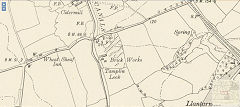
Tamplins Lock brickworks, 1899
|
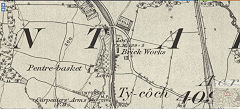
Top Lock brickworks, 1872
|
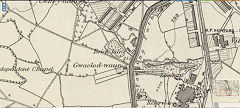
Gwaelod-waun brick kilns, 1881
|
|
Ty Coch - ST 2914 9412
The original brickworks at Ty-coch specializing in refractory or fire bricks, dated from before 1840 and is now a housing estate. The site was originally the canal basin at the lower end of the incline from Henllys Colliery, probably dating from around 1814. It was described as a 'coalworks' and owned by Joshua Hanson in 1840, the six bottle-shaped kilns of the 'firebrick' works being opened in 1842/43 by Joshua's son Cyrus. It seems one of the kilns had collapsed by 1882 but not replaced. Rail traffic carried on until 1966, a lot to do with the road entrance being a narrow lane off Two Locks Road. After Hanson's involvement the brickworks became part of the GKN empire and finally with 'GR Stein refractories' and I'm told it closed on 12th September 1986.
"Hanson Henllis" with a small acorn at the end of the imprint are likely to have been made during J.C. Hill's ownership (1874 - 1885) as the acorn was his trademark. The Patent Nut and Bolt Co took over then but still used "Hanson Henllis" without the acorn, GKN took over in 1902 still with the same imprint. It was only later that they started using their own "GKN Ltd Henllys" imprint.
Regarding double imprints, Lawrence Skuse recalls "My late brother worked briefly at Whitehead’s in the 1960s and said if they wanted a smoke break, they would contrive a stoppage for the conveyor which would reverse slightly sending some bricks for stamping twice." He has also seen double imrints on 'Star Cwmbran' and 'Blaendare' bricks.
The 'GKN Dahl' imprint is found with a wide range of numbers, the meaning of which is not clear.
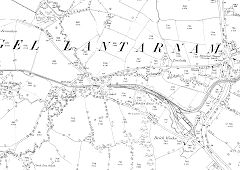
Henllys Brickworks, 1880
|

Henllys Brickworks, 1901
|
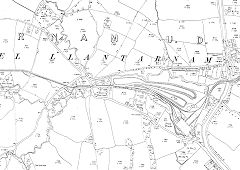
Henllys Brickworks, 1920
|
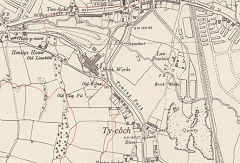
Henllys brickworks, 1949
|
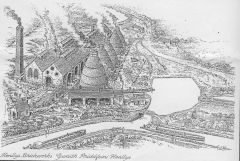
Henllys Brickworks in 1855
|
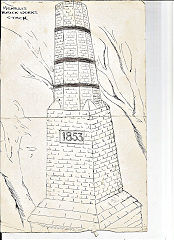
Henllys Brickworks 1853 chimney
|
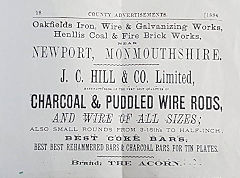
J C Hill & Co Ltd advert, 1884
|
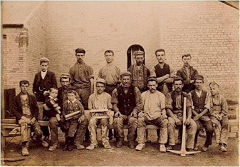
Brick workers in Cwmbran
|
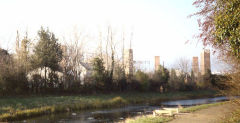
Henllys Brickworks, Oakfield, 1988
|
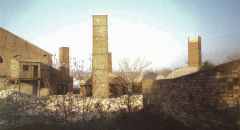
Henllys Brickworks, Oakfield, 1988
|
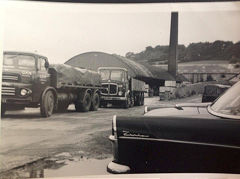
Henllys Brickworks, Oakfield, c1970s
|
|
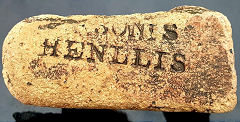
'Hanson Henllis' double imprint
|
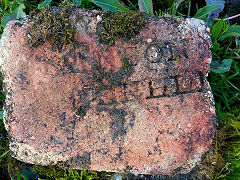
'Hanson Henllis'
|
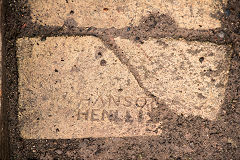
'Hanson Henllis' block
|

'Hanson Henllis'
|
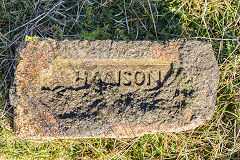
'Hanson Henllis'
|
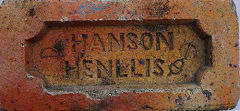
'Hanson Henllis' with acorn
|
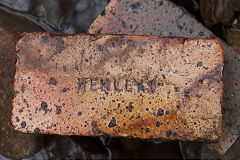
'Henllys' with small letters
|
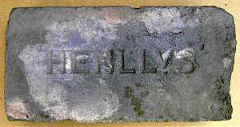
'Henllys' with large letters
|
GKN and GKN Dahl imprints
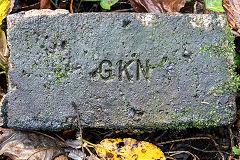
'GKN', type 1
|
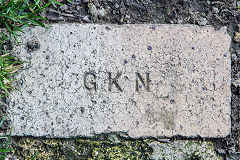
'GKN', type 2
|
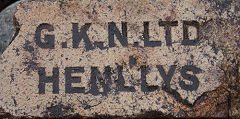
'GKN Ltd Henllys'
|
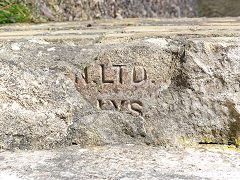
'GKN Ltd Henllys'
|
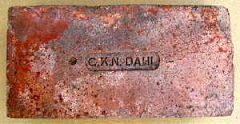
'GKN Dahl' type 1
|
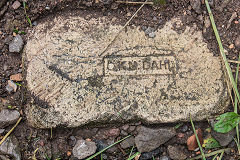
'GKN Dahl' type 2
|
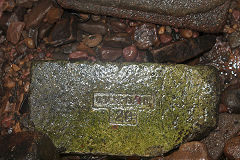
'GKN Dahl 28'
|

'GKN Dahl 37'
|
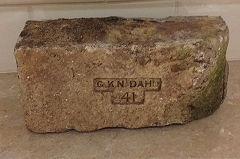
'GKN Dahl 41'
|
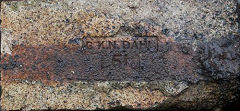
'GKN Dahl 51'
|
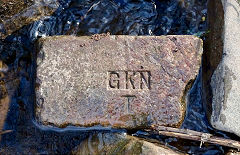
'GKN T'
|
|
Llandowlais, Oakfield - ST 2923 9409
A 'new' brickworks making ordinary house bricks, hence the 'red', was opened shortly after the second world war, c1950, at Llandowlais by Whitehead, Hill & Co. It quarried its clay from claypits to the south of the works, east of Ty-coch Lane and the canal. The brickworks itself lies under the ex-Ferranti factory on the Ty-coch Industrial Estate. Its clay pits have been levelled and are now offices and housing. There is nothing much to use as a reference point.

Llandowlais brickworks, 1949
|

Llandowlais Brickworks, 1967
|

Llandowlais Brickworks claypits
|

Llandowlais brickworks chimney
|

Llandowlais brickworks chimney
|
|
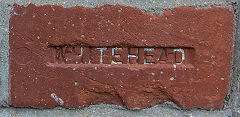
'Whitehead', type 1
|

'Whitehead', type 2
|
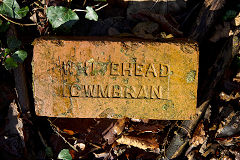
'Whitehead Cwmbran', type A1
|
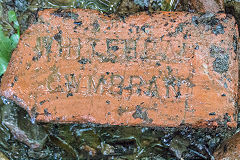
'Whitehead Cwmbran', type A2
|
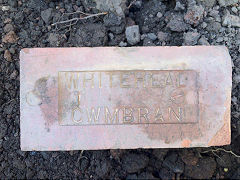
'Whitehead Cwmbran', type A3
|
|

'Whitehead Cwmbran', type B
|
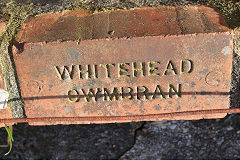
'Whitehead Cwmbran', type C
|
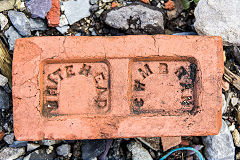
'Whitehead Cwmbran', type D1
|
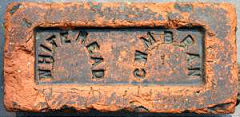 'Whitehead Cwmbran', type D2
'Whitehead Cwmbran', type D2
|
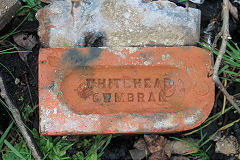
'Whitehead Cwmbran', type E1
|

'Whitehead Cwmbran', type E2
|
|
|
Llantarnam - ST 3005 9415
Llantarnam Brickworks were part of Star Brick and Tile Co Ltd, the full story of 'Star' is on the Newport Brickworks page. The brickworks were opened C1887 and sidings to the GWR Hereford line by 1895. The claypits were to the NorthWest between the railway and Llantarnam Road with the usual narrow gauge tramways. The brickworks closed down C1964. Most of the site has been re-developed as an industrial estate and housing. There were two very overgrown and dis-connected sidings at ST 3047 9378 running up to the factory perimeter from the site of the brickworks connection in 2009. Embedded rails in the footpath at ST 3023 9403 led into the 1940s Cold Storage facility and subsequent industrial estate on the site.
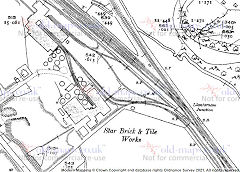
Llantarnam brickworks, 1920
|
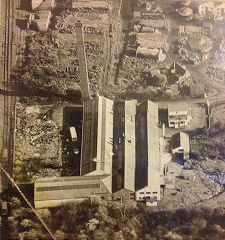
Llantarnam brickworks
|

'Star Cwmbran'
|
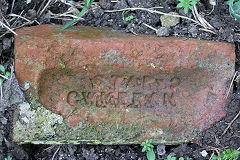
'Star Cwmbran' double imprint
|
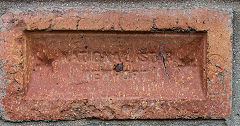
'National Star Newport L'
|
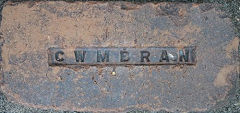
'Cwmbran'
|
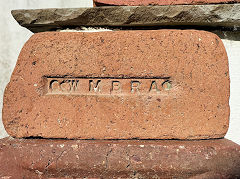
'Cwmbra'
|
|
Cwmbran - ST 294943
Next door to the vitriol works was Cwmbran Brickworks to the North of Llandowlais Street. It isn't shown on the 1887 OS map but is on the 1902. It may well have have opened around the same time as Llantarnam brickworks. On the 1920 map its marked as 'Old Clay Pit'. The pits were used as a rubbish dump in the 1950s. The site is now occupied by Cwmbran Stadium and the road system.

Cwmbran Brickworks, 1899
|

'Cwmbran Brick Co Newport'
|
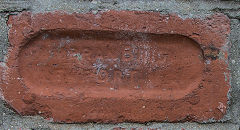
'Cwmbran Brick Newport'
|
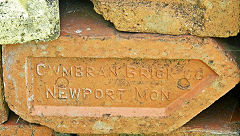
'Cwmbran Brick Co Newport Mon'
|
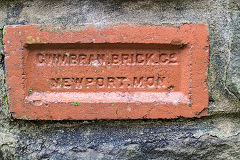
'Cwmbran Brick Co Newport Mon'
|

'Cwmbran Brick Co Newport Mon'
|
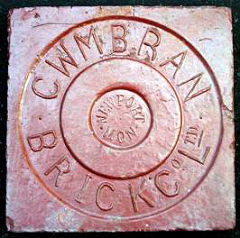
Cwmbran brickworks floor tile
|
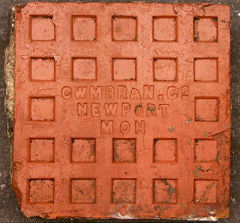
Cwmbran brickworks floor tile
|
Woodside, Forge Hammer - ST 2880 9565 and ST 2900 9585
Woodside brickworks was in operation by 1875 on the West bank of the canal but are shown as disused on the 1886 OS map only to have re-appeared on the East bank of the canal as the 'Woodside Brick & Tile Co'. The original site was cleared by 1922 and now buried under the Springvale Industrial Estate, very close to the access ramp to the nature trail. Amongst the proprietors listed in trade directories were 'Henry Bolt Sketch' of the Woodside Brick Co (1875, 1884), W J Scourse and Son, I W Scourse and Son (1907) and the Standard Brick Co, Woodside Road (1914). The works finally closed around 1926.
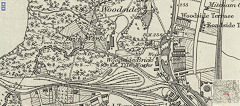
Woodside Brickworks, 1881
|
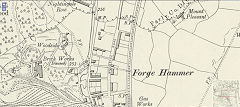
Woodside Brickworks, 1899
|
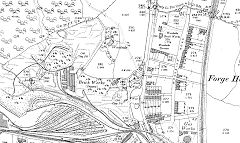
Two Woodside Brickworks, 1901
|
|
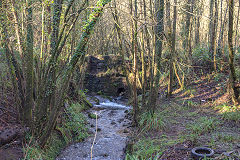
Site of Woodside Brickworks
|
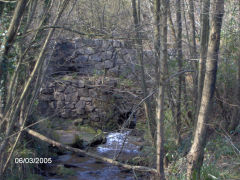
Site of Woodside Brickworks
|
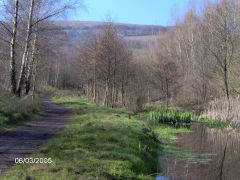
Site of Woodside Brickworks
|
|
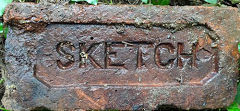
'Sketch' from Woodside
|
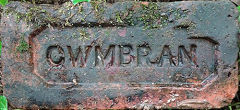
'Cwmbran' on the reverse
|
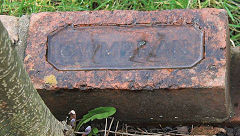
'Cwmbran' possibly from 'Sketch'
|
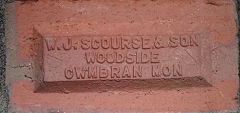
'W J Scourse and Son'
|
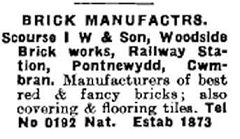
'I W Scourse and Son' advert
|
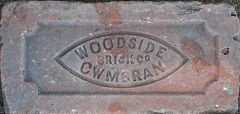
'Woodside Brick Co Cwmbran'
|

'Woodside Brick Co Cwmbran'
|
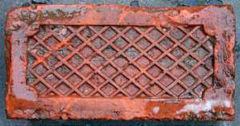
The reverse is cross hatched
|

'Woodside'
|
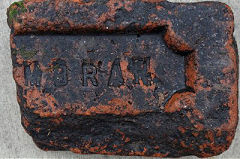
'Cwmbran'
|
|

'Standard' from Woodside
|
Pontnewydd and Upper Cwmbran
Mount Pleasant, Pontnewydd - ST 2868 9637
Mount Pleasant brickworks in Pontnewydd is shown on the 1882 OS map, run by Henry Parfitt which had good access to the Monmouthshire-Brecon canal. By 1901, the brick works had disappeared from the map, but there is a brick kiln shown on the northern side of Mount Pleasant Road. This is by Parfitt Terrace which appears to have been built close to the works, and is still standing today. Parfitt's residence, Ashley House, by the canal, was just down from the works.
In 1860 Parfitt rebuilt Cwmbran Furnace for Mr RS Roper, being presented by his obviously satisfied client with an engraved spirit level. Brick toppings to original gate posts in the Holy Trinity churchyard are made from red Parfitt bricks; Holy Trinity was opened in 1860. Parfitt moved into fire brick production in 1867, taking over the Upper Cwmbran works from John Lawrence. He has an entry in the 1871 Kelly's Directory, but the 1891 Kelly's shows him only in the firebrick section. In 1896 Parfitt was in financial difficulties and the PNB took over the Upper Cwmbran works.
Parfitt bricks from Mount Pleasant brickworks have two 'T's in their name. Those from Upper Cwmbran brickworks only appear to have one 'T'.

Mount Pleasant brickworks, 1882
|
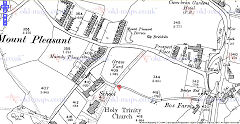
Mount Pleasant brickworks, 1901
|
|
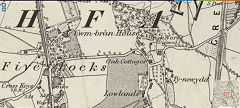
Grove Park brickworks
|
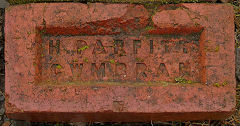
'H Parfitt Cwmbran'
|
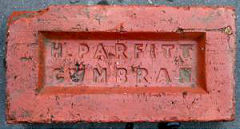
'H Parfitt Cwmbran'
|

'H Parfitt Cwmbran', reversed 'N'
|
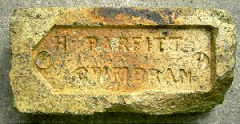
'H Parfitt Cwmbran'
|
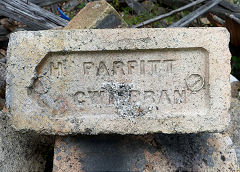
'H Parfitt Cwmbran'
|
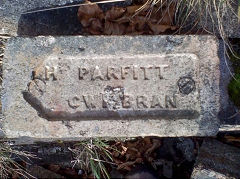
'H Parfitt Cwmbran'
|

'H Parfitt Cwmbran'
|
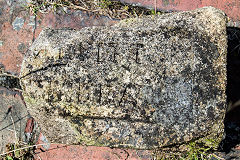
'H Parfitt Cwmbran'
|
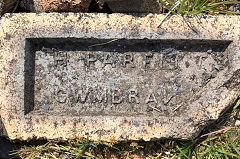
'H Parfitt Cwmbran' reversed 'N'
|
|
|
|
Grove Park, Pontnewydd - ST 2915 9700
A brickworks is shown on the 1881 OS map as 'disused'. This could have been the brickworks owned by A.H James & Co. and Davies & Co.
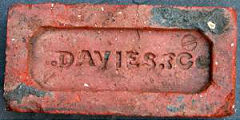
'Davies & Co'
|

'Pontnewydd' with a reversed 'N'
|

'Davies & Co'
|
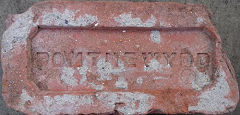
'Pontnewydd' with a reversed 'N'
|
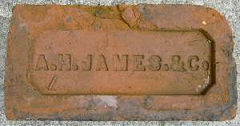
'A H James & Co'
|
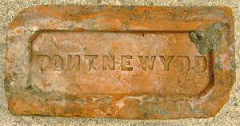
'Pontnewydd' with a reversed 'N'
|
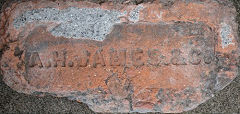
'A H James & Co'
|

'Pontnewydd' with a reversed 'N'
|
Pontnewydd (Gwent Pipe and Firebrick Co) - ST 299962
The site of the old Pontnewydd tinplate works was used by Gwent Pipe and Fire-brick Co making, as the name suggests, pipes and firebricks. It is first listed in Kelly’s of 1937It was still listed in the 1960 Industrial Directory for Wales and Monmouthshire, but in the 1960s it was taken over by Hepworth’s Pipes who also took over the Llantarnam Star Brick & Tile works and transferred their pipe production to the Pontnewydd works which itself, was closed down in 1974.
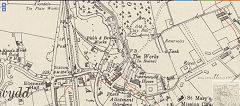
Gwent Pipe and Firebrick Co, 1948
|

Gwent Pipe and Firebrick Co, c1935
|
|

An 8 inch/200 mm diameter 'cap'
|

An 5 inch/125mm diameter 'cap'
|
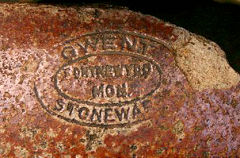
Is this part of a sump.
|
Upper Cwmbran - ST 2730 9680
The site of Upper Cwmbran brickworks is at the top of the final incline and is now occupied by the Water Board pumping station. The brickworks opened by 1839, after high-quality clay was found at Porthmawr Colliery, as the 'Stourbridge Fire Clay Company' of Ebeneezer Rogers. the company passed to John Lawrence in 1845 who opened the Mineslope Colliery, then R Blewitt who possibly operated under the name "Cwmbran Fireclay Co", Henry Parfitt in 1867, finally closing under GKN ownership in 1915. The output, when in full production was 110,000 fire bricks per week.
Parfitt bricks from Upper Cwmbran brickworks only appear to have one 'T' in their name. Those from Mount Pleasant brickworks have two 'T's.
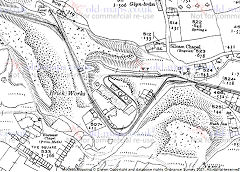
Upper Cwmbran brickworks, 1920
|
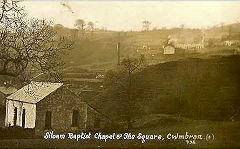
Upper Cwmbran Brickworks
|
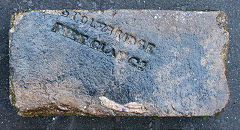
'Stourbridge Fire Clay Co'
|
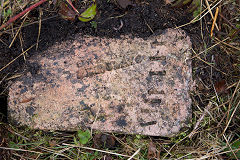
'Cwmbran Fireclay Co'
|

'Cwmbran Fireclay Co'
|

'H Parfit Cwmbran'
|
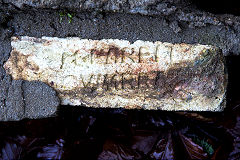
'H Parfit Cwmbran'
|
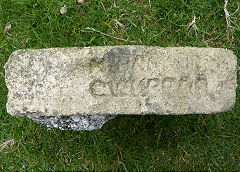
'H Parfit Cwmbran'
|
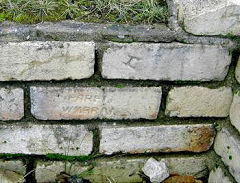
The Engine House wall
|
Other bricks found in the area
It is possible that "CB" refers to Cwmbran Brick, and is associated with this brick works, but only about four "CB 1" or "CB 2" examples have been found. Also 'E', 'H' and 'HD' are found in the area and are very likely to have come from Upper Cwmbran brickworks.

'CB', found at Abersychan
|

'CB 1', Upper Cwmbran
|

'CB 2', Upper Cwmbran
|
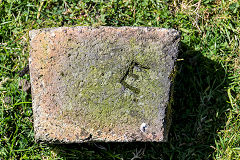
'E', Upper Cwmbran
|
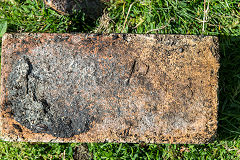
'H', Upper Cwmbran
|
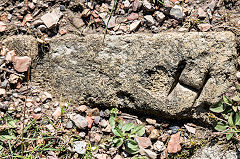
'H', Upper Cwmbran
|

'H', Upper Cwmbran
|
|

'HD' large, Upper Cwmbran
|

'HD' large, Upper Cwmbran
|
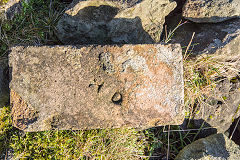
'HD' small, Upper Cwmbran
|
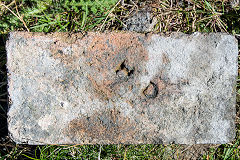
'HD' small, Upper Cwmbran
|
Panteg - ST 2941 9826
Little is known of this site which is shown on the 1882 OS map, but is absent from the 1901 map. It was situated between the School and later St Oswald's Church off Wern Road in Sebastopol. There is a tenuous reference on a genealogical site referring to someone working at the "Sebastopol Brick Yard" in 1878. No directory entries have been found for this brick works.
New Inn - ST 3036 9951
This brickworks is only shown on the 1881 OS map. Slater's Directory of 1868 gives a W.G. Williams of New Inn, as a brick maker, no further details known.

Panteg brickworks, 1881
|
|
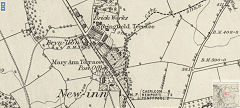
New Inn brickworks, 1881
|
Pontypool and Pontnewynydd
Thomas Gameson, Sow Hill
Thomas Gameson is named in the Mineral Statistics of 1858 as being the manufacturer of "Fire bricks, used for iron and tin works, coke ovens etc, 200,000 yearly, at Blaena (sic)". He is listed in Slater's of 1859 as brick making at Sow Hill, Pontypool, and is also listed in Slater's Directory of 1868 as making bricks at Abersychan, but where is not known. However see the entry below for Lower Race.

'T Gameson Pontypool'
|

'T Gameson Pontypool'
|
|
Lower Race Brickworks, 1840 to 1910 - ST 2742 0018
The earlier brickworks at Lower Race seems to date from the 1840s, being shown as a brickyard on the 1840 Tithe Map, occupied by Edward and Abraham Vaughan which also shows adjacent land as being occupied by John and Thomas Gameston but as a 'garden' (see above). In 1891 Henry Bythway managed the Lower Race brickworks of the Blaendare Co and, at the same time, was also the manager of the Cwmffrwdoer Brick Co. The Lower Race Brickworks was disused by 1901 and demolished by 1910.
Upper Race Brickworks, c1906 to c1948 - ST 2719 0011
By 1916 an 'Upper Race Brickworks' but still in Lower Race appears on the other side of the Blaendare road and is shown as disused in 1948. The area had been cleared on the 1962 map. This is probably the brickworks using the 'Pontypool Brick Co' imprints. The Pontypool Brick Co Ltd is first mentioned in Kellys 1906 directory at The Race, Pontypool with the last entry being in the Industrial Directory for Wales & Monmouthshire for 1948.
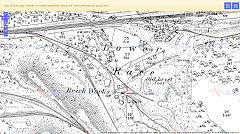
Lower Race Brickworks, 1880
|
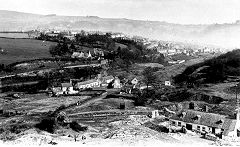
Lower Race Brickworks, c1910
|
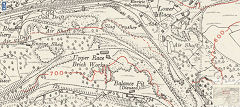
'Upper Race' Brickworks, 1916
|
|
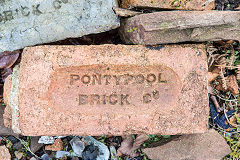
'Pontypool Brick Co' type 1
|

'Pontypool Brick Co' type 2
|
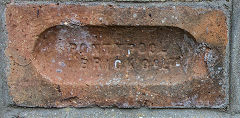 'Pontypool Brick Co Ltd' type 1
'Pontypool Brick Co Ltd' type 1
|

'Pontypool Brick Co Ltd' type 2
|
Blaendare - ST 2730 9935
In the first quarter of the 19th century the firm of Robert Farquhar and Company, of Pontypool, acted as coal merchants and owner of a level at Blaendare. The proprietors were Robert Farquhar, Edwin Allies and Andrew Maund (the father of John Maund - see the Boundary Stones page). Maund's share was sold in 1822. The business was also involved in the limekilns at Goytre Wharf on the Brecon & Abergavenny Canal. Robert Farquhar seems to have died in 1832. It appears as if this was the beginnings of the Blaendare brickworks. From the 1850s until 1906 it was owned by the Blaendare Co Ltd or Blaendare Colliery Co Ltd when the Pontypool Brick Co Ltd came into being. The works is in trade directories up to 1948, is on OS maps up to 1954 and had disappeared by 1962. Blaendare Farmhouse above the site was built in 1810 using hand-made bricks from Blaendare Brickworks for the Brickworks manager.
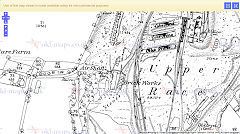
Blaendare Brickworks, 1880
|
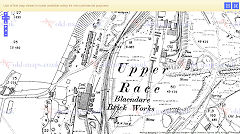
Blaendare Brickworks, 1901
|

Blaendare Brickworks, 1920
|
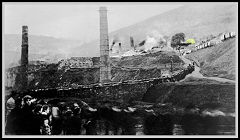
Blaendare Brickworks
|
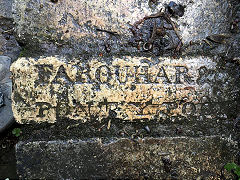
'Farquhar & Co Pontypool'
|
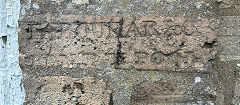
'Farquhar & Co Pontypool'
|

'Farquhar & Co Pontypool'
|
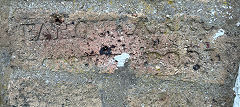
'Farquhar & Co Pontypool'
|
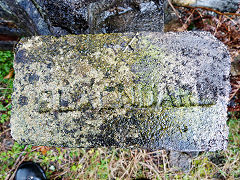
'Blaendare'
|
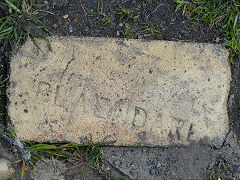
'Blaendare'
|
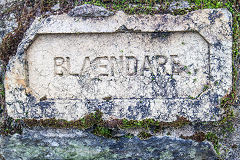
'Blaendare'
|

'Blaendare'
|
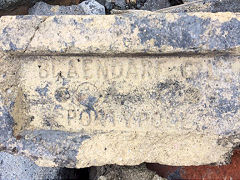
'Blaendare Co Pontypool'
|
|
|
|
Cwm Lickey - ST 2742 9900
In the mid 1950’s the Star Brick Company produced the very first breeze blocks from the waste or spoil from the mines around Blaendare and Cwm Lickey. There are many bricks, some imprinted with “Star”, lying around but the venture doesn't seem to have been too successful.

Star Brick Co's block works
|
|
|
|
Little Mill, Pontypool - SO 3150 0220
Originally shown as 'Bryntovey Brick Works' on OS maps, this works was started by John Burgoyne in 1850 according to his bricks! The name was changed to 'Little Mill Brick Co' around 1910 and the works continued until the 1980s, becoming a Go-Kart track.
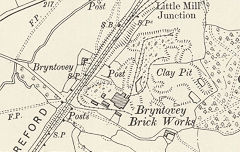
Little Mill brickworks, 1899
|
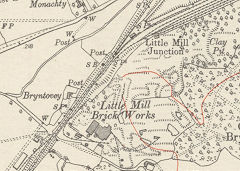
Little Mill brickworks, 1948
|
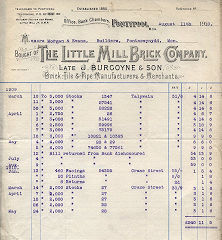
'The Little Mill Brick Co' invoice
|

'The Little Mill Brick Co' receipt
|
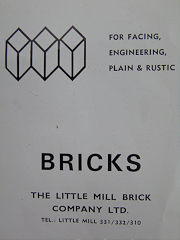
Little Mill Brickworks advert
|
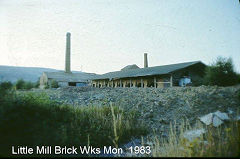
Little Mill Brickworks in 1983
|
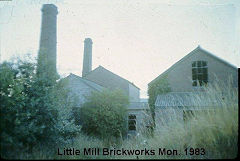
Little Mill Brickworks in 1983
|
|
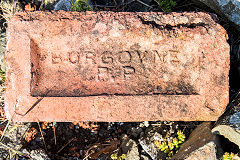
'Burgoyne PP'
|

'Burgoyne PP'
|
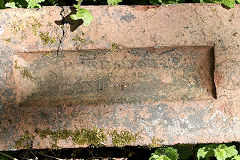
'Burgoyne est 1850 PP'
|

'Burgoyne est 1850 PP'
|
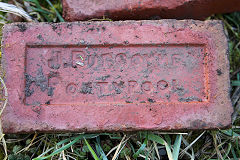
'J Burgoyne Pontypool'
|
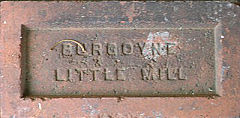
'Burgoyne Little Mill'
|
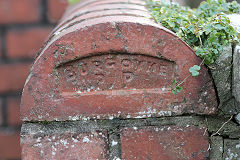
'Burgoyne P P' coping stone
|
|

'Little Mill', type 1,
|
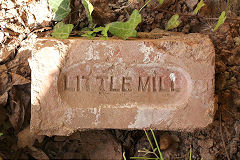
'Little Mill', type 2
|
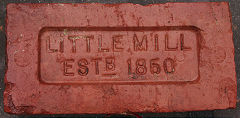
'Little Mill Estb 1850'
|
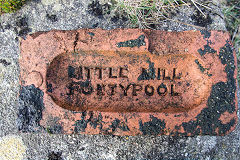
'Little Mill Pontypool'
|
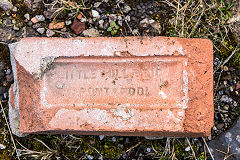
'Little Mill Brick Pontypool', type 1
|
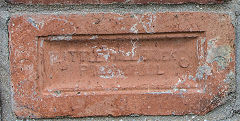
'Little Mill Brick Pontypool', type 2
|
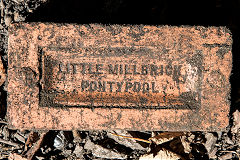
'Little Mill Brick Pontypool', type 3
|
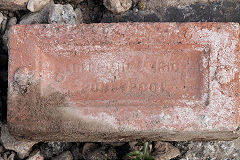
'Little Mill Brick Pontypool', type 4
|

'Little Mill Brick Co Pontypool'
|
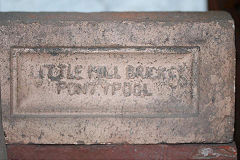
'Little Mill Brick Co Pontypool'
|
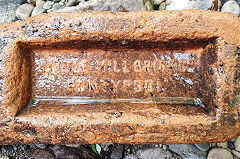
'Little Mill Brick Co Pontypool'
|

'Little Mill Brick Company Pontypool'
|
Pontnewynydd Iron Works - ST 2717 0174
Brick kilns are shown within the Pontnewynydd Iron Works on the 1879 OS map but not on the 1899 survey.
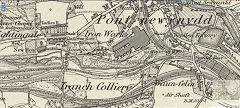
Pontnewynydd brick kiln, 1879
|
|
|
|
Plas-y-Coed, Cwmffrwdoer - SO 2621 0138
In 1874 a partnership between proprietors of a colliery and brickworks in 'Cwmfrwdore' was dissolved. One of the partners, George Jee, was building houses in Plas-y-coed in 1892 so these may be the original proprieters of Plas-y-coed Brickworks. In 1879 the 'Pontypool Firebrick and Coal Co Ltd' is advertised for sale by auction in the Pontypool Free Press and in 1891 Kellys records the Cwmffrwdoer Brick Co managed by Henry Bythway who, at the same time, was also the manager of the Lower Race brickworks of the Blaendare Co. From 1879 to 1899 the site is shown on OS maps. but by 1917 the site is shown as the Eastern Valleys Blackvein Colliery, which closed in 1939.
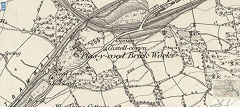
Plasycoed brickworks, 1879
|

Plasycoed brickworks, 1899
|
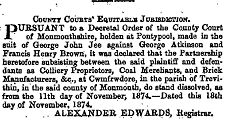
Dissolution of a partnership
|

Pontypool Firebrick and Coal Co
|
Pontnewynydd (Oak Brickworks) - SO 2654 0172
The Oak Brick Co Ltd first appears on the 1899 OS map and is listed in Kellys in 1901. They produced house and fire bricks and pipes until the late 1960s or early 1970s. Fireclay was obtained from J & W Jones, Snatchwood Slope, Pontnewynydd in the 1920s. At the same time, John Maybury was chairman of the Oak Brick Co, Pontypool, so it is possible bricks with the 'Maybury' imprint were produced at the Oak works.
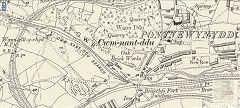
Oak brickworks, 1899
|
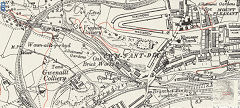
Oak brickworks, 1938
|
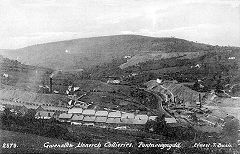
Oak brickworks and Collieries
|
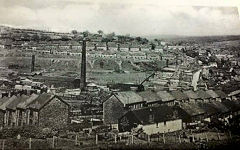
Oak Brickworks
|

A runaway train at Oak Brickworks
|
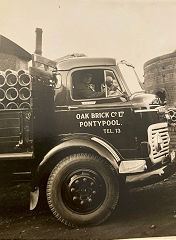
Oak Brickworks lorry, 1958
|
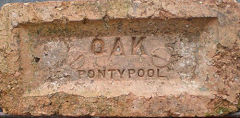
'Oak Pontypool'
|
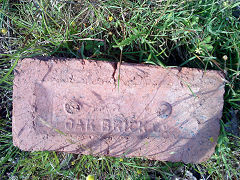
'Oak Brick Co'
|
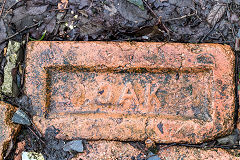
'Oak' type 1
|
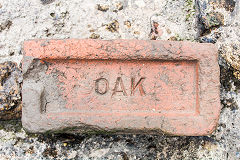
'Oak' type 2
|
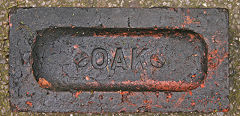
'Oak' type 3
|
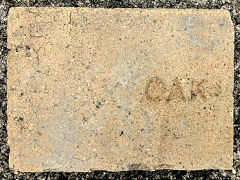
'Oak' type 4
|
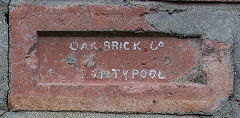
'Oak Brick Co Pontypool', type 1
|
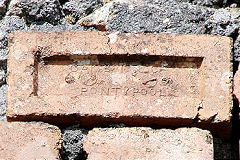
'Oak Brick Co Pontypool', type 1a
|

'Oak Brick Co Pontypool' type 2
|
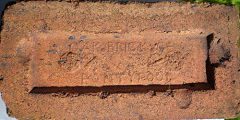
'Oak Brick Co Pontypool' type 3
|
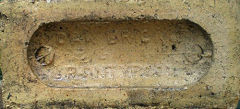
'Oak Brick Co Pontypool' type 4
|
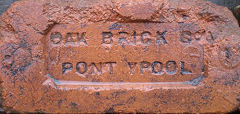
'Oak Brick Co Pontypool' type 5
|

'Oak Pontypool Mon British Make'
|
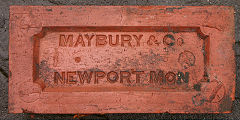
'Maybury & Co Newport Mon'
|
Graig-ddu, Cwm-nant-ddu - SO 2542 0205
The Graig-ddu Brick Co was an old-established brickworks, the National Archives have records from 1832 to 1907. It is mentioned in the 'Mineral Statistics Directory' for 1858 as the 'Graigddu Brick Co' and subsequent trade directories. Around 1895 Southwood Jones, of the Danygraig brickworks in Risca, took over the operation. It was disused by 1962.
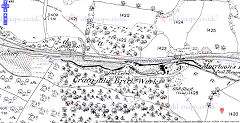
Graig-ddu Brickworks 1880
|
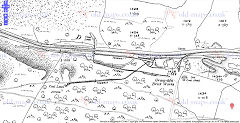
Graig-ddu Brickworks 1920
|
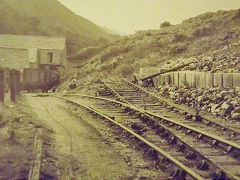
Graig-ddu Brickworks 1951
|
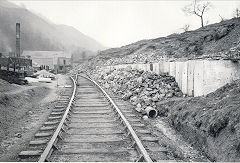
Graig-ddu Brickworks
|

Graig-ddu Brickworks 1992
|
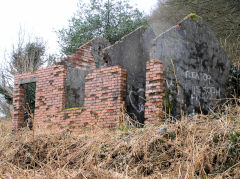
Western building
|
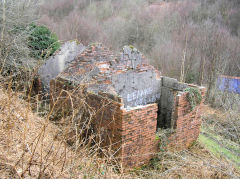
Western building
|
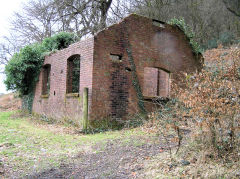
Eastern building
|

Eastern building
|
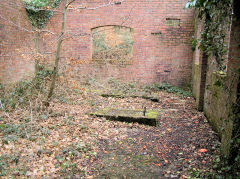
Eastern building
|
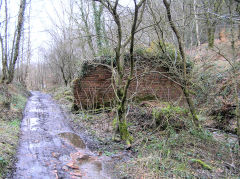
Eastern building
|
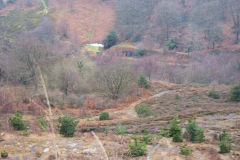
Graigddu Brickworks
|
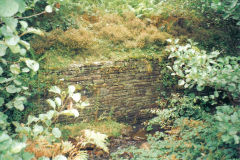
Graigddu Brickworks, GWR branch
|
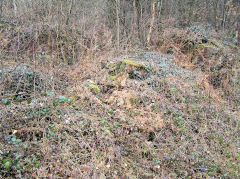
Graigddu Brickworks kiln area
|
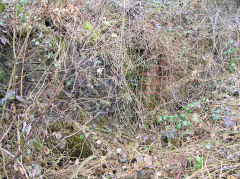
Graigddu Brickworks kiln area
|
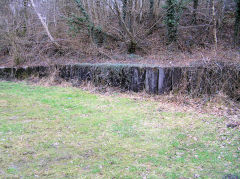
Graigddu Brickworks yard
|
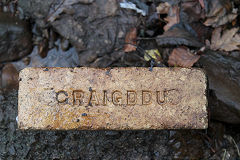
'Graigddu', possibly a coping stone
|

'Graigddu British Made'
|
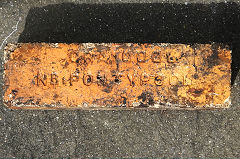
'Graigddu Nr Pontypool'
|
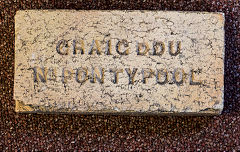
'Graigddu Nr Pontypool'
|
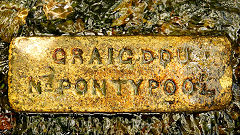
'Graigddu Nr Pontypool'
|
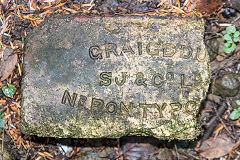
'Graigddu SJ and Co Ld Nr Pontypool'
|
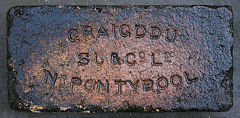
'Graigddu SJ and Co Ld Nr Pontypool' with the 'J' reversed
|
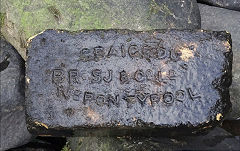
'Graigddu BR SJ and Co Ld Nr Pontypool'
|

'Graigddu BR SJ and Co Ld N Nr Pontypool'
|
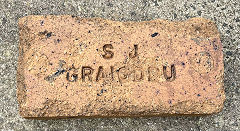
'S J Graigddu'
|

'S J Graigddu British Made'
|
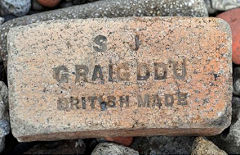
'S J Graigddu British Made'
|
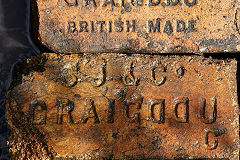
'S J & Co Graigddu C'
|
|
|
|
Abersychan and Blaenavon
Pentwyn, Abersychan (Abersychan Brick Co) - SO 2665 0285
The brickworks at Pentwyn first appears on the 1901 map but by 1978 the site is marked "tips - disused". J Gregory & Co are listed in the 1906 Kelly's as being at Pentwyn, Abersychan, in both house and fire brick sections. Cope's Directory of 1907 lists Gregory, J & Co, Pentwyn Works. Kelly's of 1926 gives the Abersychan Brick Company as being at Pentwyn, Abersychan, presumably having taken over the site from J Gregory. The 1948 Industrial Directory of South Wales and Monmouthshire names the firm as Abersychan Brick & Slag Co, and in 1960, the same publication lists it as the Abersychan Slag Ballast Co. The last reference to this company is in the 1964 Industrial Directory of South Wales and Monmouthshire.
Bricks with the imprint "Gregory & Co, Pontnewynydd" are likely to have been produced at the same works as only the 'Oak Brickworks' is known to be at Pontnewynydd for any length of time.
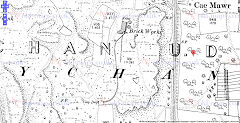
Abersychan Brickworks, 1901
|
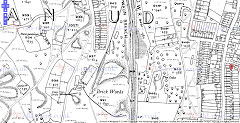
Abersychan Brickworks, 1920
|
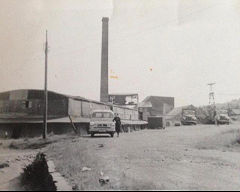
Abersychan Brickworks, c1950s
|

Abersychan Brickworks, c1950s
|

Brickworks vehicle garage
|

'Gregory Abersychan'
|
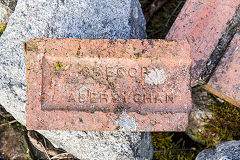
'Gregory Abersychan'
|
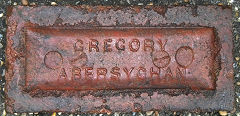
'Gregory Abersychan'
|
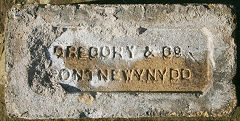
'Gregory & Co Pontnewynydd'
|
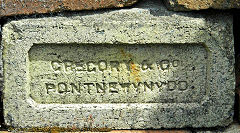
'Gregory & Co Pontnewynydd'
|
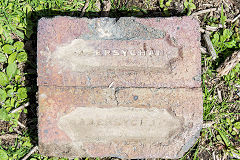
'Abersychan'
|
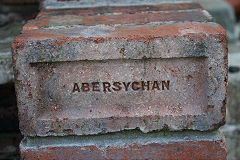
'Abersychan'
|
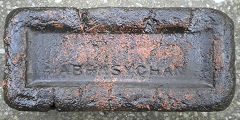
'Abersychan'
|
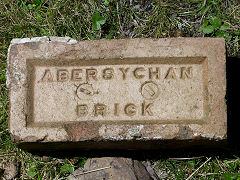
'Abersychan Brick'
|
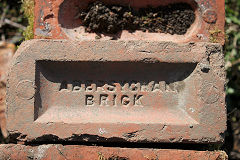
'Abersychan Brick'
|
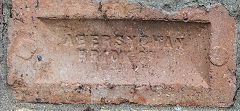
'Abersychan Brick Co'
|
The British Iron Works - SO 2587 0374
There were brick works at The British, part of the iron works site, supplying bricks to the works there.
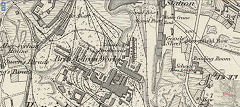
The British brickworks, 1879
|
|
|
Blaenavon
There were three brick works in Blaenavon primarily supplying the Iron Works and town.
The Bunkers Hill (upper) Brick Works at SO 2515 0955 was the main brickworks in Blaenavon. It is believed to have started in 1788, and is on OS maps up to 1938 but not the 1948 edition. At the site there is still a dry wall made up of tuyeres and other refractory items.
The middle brickworks at SO 2530 0930 is shown on the 1883 map but had gone by 1901.
The lower brickworks at SO 2475 0920 is shown on the 1883 map, disused by 1901 and gone by 1920.
A later works is reported from 1960 to 1981 in the Industrial Directory for Wales and Monmouthshire, listing Pickford & Holland as making fire bricks in Forgeside, Blaenavon. The Directory of Quarries, 1969 and 1973 lists "Pickford, Holland & Co Ltd, 381 Fullwood Road, Sheffield; Basic Brick Works, Blaenavon, Mon. Tel Blaenavon 271. (Silica, Chrome, Magnesite, Silimanite, Bricks and Cement)".
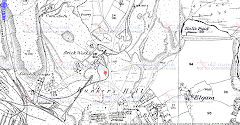
Bunkers Hill Brickworks, Blaenavon
|
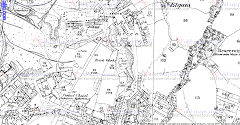
Middle Brickworks, Blaenavon
|
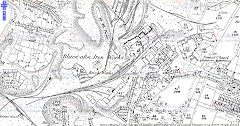
Lower Brickworks, Blaenavon
|
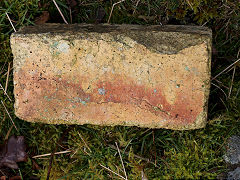
Brick found by Meadow Vein Level
|
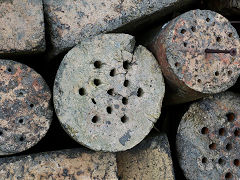
Bunkers Hill Brickworks, Blaenavon
|
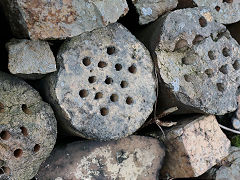
Bunkers Hill Brickworks, Blaenavon
|
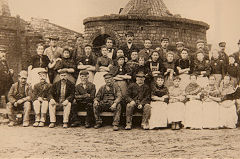
One of the Blaenavon Brickworks
|
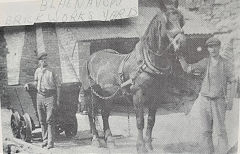
Bunkers Hill Brickworks, Blaenavon
|

'P H Alosil'
|
Acknowledgments, sources and further reading.
Thanks particularly to Lawrence Skuse, who is
'Cold War Warrior' on Flickr.com for starting the whole thing off with his 'Brickworks of Torfaen' document, here in .pdf version:-
'The Brickworks of Torfaen'
A great many other people have supplied information and photos of Monmouthshire's brickworks and their bricks, so many thanks to (alphabetically) Graham Bennett, Jim Brook, Phil Burgoyne, Ian Cooke, Steve Davies, Howard Daley, John Elliott, Andrew Harvard, Tracey Hucker, Deniol Iago, Nigel Jones and the late 'Cwmbran.info' website, Mike Kilner, Norman Lowe, David Martin, Richard Paterson, Ian Pickford, Dave Sallery, Mike Stokes, Ian Suddaby, Scott Tanner, Gareth Thomas, www.tredegar.co.uk, Brian Waters, Mark Young.
The Brocross/Penmorfa website is the best source of info on bricks and brickworks in the UK :-
Old Bricks - history at your feet
For very good coverage of Scottish bricks and quite a bit about other places too :-
Scottishbrickhistory.co.uk
Martyn Feltwell has two very good sites here :-
East Midlands Named Bricks and
UK Named Bricks
There is a specialist society for brick history :-
British Brick Society
There's also a 'Facebook' group for bricks and brickworks :-
'UK Bricks and Brickworks Past'
A Guide to the Website
Industrial Wales
Collieries, Ironworks, Quarries, Railways, Canals, Tramroads, Tunnels, Culverts and so much more....
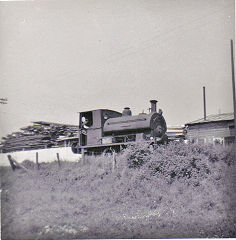
|
Brickworks of Wales
Bricks are 'History with a label' so here's the story of the Brickworks of Wales - photos, maps and the products themselves
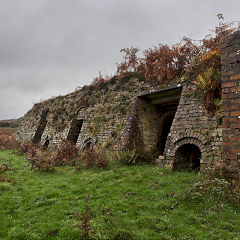
|
Around the World
My travels around the UK and the Whole Wide World in search of industries, railways, trams and mines to name a few.
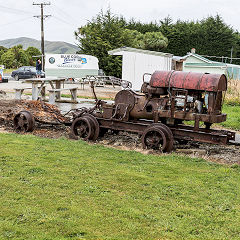
|
Boundary Stones and Mileposts
Boundary Stones, Mileposts and other markers in simple alphabetical order of their initials, name or site.

|
Ships and Shipping
Ships around the World in simple alphabetical order of their name (or apparent area if I can't read the name).

|
The Site Map and Index
A full list of all the pages of the whole website in just one place, so you should find exactly what you are looking for.

|
About the Site
The background and technical details about the site, plus a contact page and links to other sites - and a warning !!
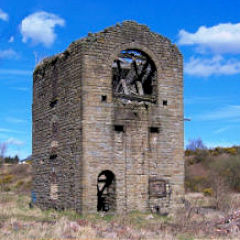
|
Contact Me
Something to add? A great photo? Something wrong? or need to know more about things? Just drop me a line here.

|
Further Reading
You can find lots of local and other very helpful websites, books, magazines and Facebook groups all listed here.
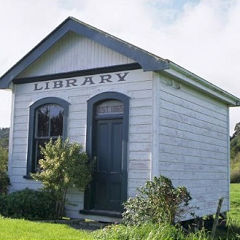
|
All rights reserved - Phil Jenkins






























































